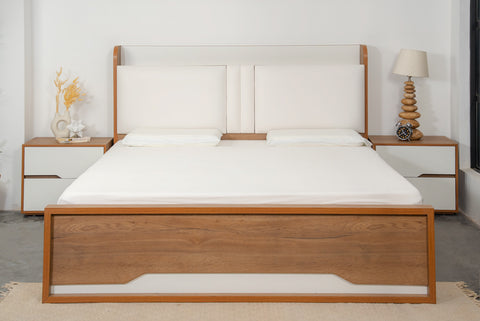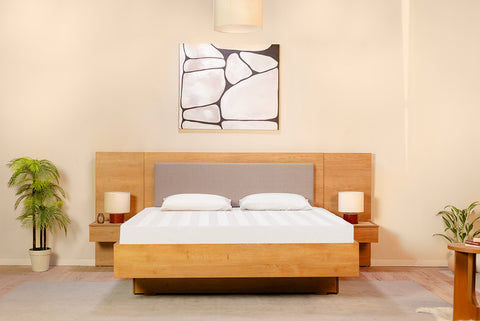Finding the Perfect Fit: How to Choose the Right Side Table Height for Your Bed or Sofa
A side table does more than fill a space. It offers a place for a lamp, a book, or a glass of water. But if it’s too tall or too low, it can feel awkward and even unsafe in the dark. Choosing the right height ensures the table supports your routines and looks balanced with your furniture.
At MoltyHome, furniture is designed with intention and clarity. Our pieces serve real life, not fleeting trends. This guide will help you choose the ideal height for your side table, whether it sits next to a bed or a sofa, without sacrificing comfort or style.
Why Side Table Height Truly Matters
A table that’s too high forces you to reach up. Too low, and you bend down awkwardly. We might not notice these small details until they make daily tasks uncomfortable.
Experts recommend that a side table aligns within two inches of the sofa’s armrest or the top of your mattress for ease and comfort. A standard table height ranges from 18 to 28 inches, depending on the purpose and furniture height. Proper height supports natural habit and correct posture. It also helps the room feel visually balanced, since all proportions will feel intentional and comfortable.

Finding the Right Height for Bedside Tables
When choosing a bedside table, aim for it to align with the top of the mattress or sit no more than 2 to 4 inches above it.
Here’s why it matters:
- Ease of access—when you wake in the night, you can reach essentials quickly.
- Visual balance—matching height creates harmony in the space.
- Communication of scale—a mismatched bedside feels off, even if you don’t first notice it.
If your bed sits high, perhaps with a plush mattress, you should choose a slightly taller table. But if the difference grows beyond 4 inches, consider restoring balance with a lower table or elevated hardware.
Finding the Right Height for Side Tables Beside Sofas
The ideal height for a side table beside a sofa is within 1–2 inches of the sofa’s armrest.
What is the purpose here?
- Effortless reach—you should not strain or lift your arm to set down a drink.
- Ease in daily use—whether reading, holding remote controls, or styling with a lamp.
- Visual continuity—matching height blends the seating with the accessory.
Going taller than the armrest can feel clumsy. Going significantly lower may look out of place and won’t support use as comfortably.
Balancing Style and Practicality
A great side table achieves both form and function. Visual balance matters. A table that’s too tall can feel imposing; too short, and it disappears from view.
Consider:
- Proportion: Choose a table that complements the scale of the surrounding furniture.
- Top usability: Tables should hold lighting, books, or décor without crowding the space or creating imbalance.
- Design flexibility: A simple table in a neutral finish works in many layouts and invites future shifts in décor.
MoltyHome designs with this balance in mind, offering proportions that feel natural beside sofas or beds, without distracting from the space.
Measuring for Comfort and Accuracy
Before buying, take the following steps:
- Measure the height from the floor to the top of the mattress or the sofa arm.
- Look for a table within ±2 inches of that measurement.
- Test with temporary objects like books or stacked trays before committing.
- Leave a few inches between the table and furniture to prevent bumping.
This ensures the piece supports how your room functions without guessing.
MoltyHome Side Tables for Every Need
MoltyHome offers side tables built to complement both form and function:
- Aspen Side Table suits lower sofas or beds with modest height.
- Jace Side Table aligns well beside sofas with higher arms, maintaining ease of reach.
- Harper Side Table pairs seamlessly with beds and dressers of standard to moderate height.
Each design follows ergonomic guidelines and aesthetic balance, staying true to MoltyHome’s commitment of thoughtful design for real living spaces.
Conclusion
Choosing the correct height for your side table is simple, but impactful. When you match the table to your bed or sofa, within about two inches, you enhance both usability and the room's visual flow.
MoltyHome side tables are designed with that balance in mind: made to fit, made to last, and made to feel right in real homes. Take a moment to measure, consider purpose, and let the furniture serve your daily life with ease.
Frequently Asked Questions
What is the ideal height for a bedside table?
Target the same height as the mattress or within 2 inches above or below
How tall should a side table be next to a sofa?
Match the height to the armrest, typically within 1–2 inches for easy reach.
What if I can’t match the exact height?
Go a touch shorter rather than taller. Easy access is more comfortable than forced reach.
Do different styles of furniture affect table height choice?
Yes, taller sofas or platform beds may require proportionally taller tables for harmony.
Can I pair mismatched side tables?
Yes, as long as they share the same height and visual weight, they’ll feel intentional rather than random.







